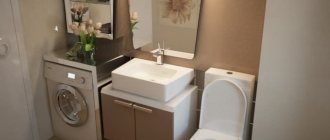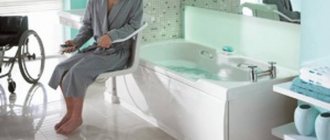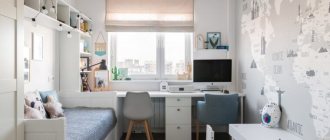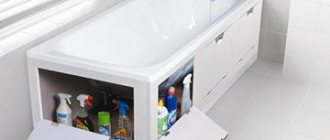Icer
8194 0 0
Icer August 1, 2016Specialization: master in the construction of plasterboard structures, finishing work and laying floor coverings. Installation of door and window units, finishing of facades, installation of electrical, plumbing and heating - I can give detailed advice on all types of work.
If a person with disabilities lives in a house or apartment, then it is very important to create the best living conditions for him. In this review, I will tell you how to equip a toilet for wheelchair users and people with musculoskeletal disorders. Please read all recommendations carefully and choose the option that best suits your situation.
In the photo: in some cases it is enough to install railings near the toilet so that a person can use the toilet independently
Types of toilets and recommendations for their selection and installation
First, let's study what types of systems there are, then we'll figure out the requirements that they must meet. I will also tell you how to implement a stationary option so that you can do the work yourself.
Sometimes the only possible solution is a special chair with a removable container, but it is still better to choose another option
Types of systems and requirements for them
Depending on the design features, several main options can be distinguished:
| Toilet chair | This option is simple and consists of a chair with handrails, a backrest and a removable container. The main advantage is mobility, so if you need a portable type of system, then this is what you need, because if necessary, the structure can be placed anywhere. When choosing, I advise you to pay attention to the possibility of adjusting the height of the structure and its reliability |
| Dry toilet | A more advanced solution that resembles the type of product described above, but has a number of advantages. First of all, it should be noted that the dry closet allows you to effectively combat unpleasant odors, and its cleaning is much easier than the classic options, because it has a quick-removable tank |
| Toilet cover | Toilet covers, or toilet attachments as they are also called, allow a disabled person to use the same plumbing fixtures as other people. Just before use, a special structure is installed, which is equipped with handrails, with its help a person with disabilities can independently visit the toilet |
| Installation of handrails | To ensure ease of use, railings and handrails are installed near the toilet. It is important to correctly position all the elements and secure them very securely. I will consider this option in detail below, here I will only note that this solution allows you to solve the problem once and for all, and no unnecessary inconvenience will be caused to other family members |
| Special lift | This option is used in cases where a person’s musculoskeletal system disorders are significant and he cannot transfer from a wheelchair to a toilet. The price of such systems is quite high, but in some cases they are the only solution that may be suitable |
When choosing a system, you must first take into account the wishes of the person who will use it. It is necessary to provide the person with maximum convenience and comfort, so do not try to decide what will be better on your own.
To create a comfortable space, you need to know how a person transfers from a stroller to a toilet
Now let's look at the main factors that you need to keep in mind. Whatever you choose from the above list, the design must meet several requirements:
- The manufacturing material must meet all sanitary requirements and should not cause allergic reactions in humans. You also need to take into account factors such as surface wear resistance, resistance to aggressive influences, and corrosion resistance. The easiest way is to ask the seller to provide documents confirming the design’s compliance with all regulatory requirements established in our country;
Stainless steel is an excellent solution for any type of structure
- The design should be such that it is comfortable for a person to sit in it. That is, you need to take into account height, build and other anthropometric parameters in order to choose the best option. I also advise you to pay attention to the strength of the system; it must withstand heavy loads, because if any element breaks and no one is home, a person with disabilities can lie on the floor for several hours;
- Caring for the elements should be as simple as possible. That is, all surfaces should not absorb moisture and dirt; this will allow them to be washed with a sponge or rag quickly and efficiently. Due to the fact that cleaning must be carried out very often, this aspect becomes very important.
Of course, many other aspects should be taken into account: from taking into account the design of the stroller used by a disabled person, to the maximum convenience of the design for everyone who lives in the house, because sometimes it turns out that the installation of handrails creates a lot of interference for those who do not use them.
How to install the structure
I'll talk about several options and start with the simplest ones. Everything is simple with them:
- A simple toilet chair is installed where it will be convenient for a person to sit on it and where it will not interfere with others. Remember that when using this option, an unpleasant odor will inevitably form, so it is better to place it not in the living room, but in the corridor, if possible. A good solution is a design on wheels, but it is important that they are quickly locked to ensure immobility;
This option is good for its portability and simplicity.
- a home dry toilet is that, if properly maintained, it does not emit unpleasant odors. It is easy to care for and wash, and the system can be installed in any convenient place. I recommend using this option in cases where a person cannot leave the room and the structure needs to be installed in a living space;
A dry toilet for a home for the disabled can also be installed in a residential area
- Devices that are placed on a standard toilet are called linings . As for their installation, everything is very simple: you need to choose an option that suits the configuration of your toilet, then install it and check how securely it is located. Most often, there is a special clamp in front that holds onto the rim of the bowl.
The ability to drop the handles is a useful design feature
Handrails for disabled people in the bathroom and toilet are a more solid and durable option. And as practice shows, if the elements are installed correctly, a person with disabilities will be provided with the greatest possible convenience.
But in this case, it is important to follow several recommendations so that the result is as good as possible:
- First of all, you need to make an approximate project, which will determine the position of the plumbing and the location of the handrails. It is very important to take accurate measurements of the room and calculate everything correctly, because you need to be able to maneuver in a wheelchair. Below are options for the layout of the room and show how to install a toilet;
The smaller the room, the more important the correct layout
- Next, you need to think about which handrail configuration will be optimal. To do this, it is best to consult with the person who will use the design, because the nature of the violations may be different and you need to choose exactly the solution that is suitable for a particular person and will take into account all his features. Make a sketch of the future design to visually represent it, so it will be easier for you to look for the best option;
If there is a sink nearby, then it makes sense to make a common structure of two elements
- You can choose a specific type of design both in stores in your city and on specialized websites on the Internet. If nothing fits your premises, then there is the option of ordering an individual project; manufacturers can implement any idea; you only need exact dimensions;
Based on your sketch, the manufacturer will make an accurate drawing and produce a handrail
- Another factor that I recommend paying close attention to is the choice of reliable and high-quality fasteners, the strength and safety of the entire structure depends on this. For concrete and brick walls, anchor bolts are used, for foam and aerated concrete - special dowels, and for wood - self-tapping screws of the appropriate size and thickness;
- Once you have the finished version, you can begin preparing the workflow. The first step is to attach all the elements and make sure that they fit and are positioned as intended. After this, future attachment points are marked; do this using a level so that the handrails are level;
The more accurate your markings, the easier it is to carry out the work.
- The handrails are fastened using the fastening option you choose; each element must be fixed very securely and hold still even with considerable force. Lastly, plugs, if any, and linings are installed to increase the comfort of use (they should be made of a material that does not absorb water and dirt).
Pads allow for better grip on the handrail
If your walls are not very strong and there are doubts that the handrails will hold securely, then the only solution will be through fastening. That is, the wall is drilled through and a metal plate is placed on the back side; this option will provide excellent strength even on not very high-quality foundations.
I would also like to touch upon such an option as a folding handrail. This solution is very suitable if several people use the toilet and stationary railings interfere with the use of the toilet and bathtub. Here it is important to choose a reliable option (many people believe that such structures are less durable, but this is not true) so that it can be easily reclined and, when installed in the working position, becomes motionless and rigid.
Folding options are a very practical solution
As for the price of products, depending on the configuration and material of manufacture, it can vary from 3 to 15 thousand rubles.
I would also like to talk about an option called a lift; it does not apply to railings, but with its help people with severe musculoskeletal disorders can use the toilet independently. I’ll tell you in a nutshell how to attach it:
- A supporting frame is fixed to the wall next to the door to the toilet; it is important to fix it as securely as possible;
- Next, the structure of the lift is installed; all the features of the process will be indicated by the instructions, which are always included in the delivery kit;
- The last step is to connect to the working network, after which the system is ready for use. Control is carried out using a remote control; a disabled person can control the process himself, which is very important.
A lift is the best option in terms of convenience.
The only disadvantage of an electromechanical lift is its price - it is about 100,000 rubles.
Requirements for sanitary facilities for disabled people
The dimensions of the bathroom for MGN should allow for the placement of the necessary sanitary equipment and provide comfortable conditions for wheelchair users. Premises of complex shape are excluded; moving in them is difficult for wheelchair users. Design standards do not answer this question exactly, but the dimensions are determined taking into account the equipment to be placed (handrails and auxiliary elements) and plumbing fixtures (washbasin, toilet, etc.) and to ensure convenient access to them for people with limited mobility. The square shape is also not optimal, because... When installing equipment, the surface of the walls is used.
Optimal shape
– rectangular, with the ratio of the sizes of the long and short sides being one to one and a half, and the dimensions are determined based on the rational placement of the equipment.
The floor must be level with the floor surface of adjacent rooms.
If there is a difference in height between adjacent rooms (corridor, hall), a ramp is necessary. The size of the entrance opening is at least 90 cm. With a narrower opening, wheelchair access is not possible.
Bathroom plan for MGN
Doors are chosen to open outward. The doors are equipped with special markings in the form of relief signs at a height of 1.35 m from the floor level. The bathroom for disabled people is equipped with an alarm system.
Bathroom layout plan
The alarm button is located at an accessible distance from the plumbing equipment (toilet, shower tray) at a height of 90 cm from the floor. Light warning signals are placed above the entrance.
Toilet scan along axis 1-1
They are triggered when the alarm button is pressed. It is convenient to place several wireless call buttons in the MGN room. The flashing of the warning signal indicates that the duty personnel have been called. The alarm signal is transmitted to the duty personnel and to the security post.
Axis scan 2-2
When placing a restroom for MGN, it is necessary to take into account which rooms are located above and below. It is more rational to place rooms with wet processes one above the other floor by floor. This simplifies the process of laying communications and reduces the length.
Axis scan 3-3
It is also necessary to provide a ventilation system. It is unacceptable to mark bathrooms above electrical panels. From the point of view of building operation, it is undesirable to place restrooms above offices with large crowds of people (halls, lobbies, halls, etc.).
Scan along 4-4 axis
If a separate room is not allocated for a bathroom for disabled people, provide an equipped cabin for a common toilet. Dimensions are regulated:
- Width at least 1.65 m, depth - 1.8 m, without shower tray.
- 2.2m. by 2.25 m., when installing a shower tray.
When placing plumbing equipment, it is necessary to provide a free space of at least 1.4 m wide for convenient turning of the stroller. When placing a separate special equipped cabin in a common bathroom, it is necessary to take into account that visitors in a wheelchair are accompanied by people of the opposite sex, therefore, when organizing the entrance to such a cabin, it is advisable to provide a vestibule separating the entrance to the cabin from the common bathroom.
Conventionally, the toilet can be divided into functional zones: equipment placement, an area for wheelchair movement and transfer zones to the equipment. Based on the placement of these zones in the room, the correct location of the equipment is determined.
With proper and compact placement of the necessary elements with a functional organization of space, the minimum size of the bathroom will be ensured. It is influenced by the dimensions of the equipment adopted in the project and their placement.
Useful tips
To ensure maximum convenience and safety, you need to remember a few simple rules that will ensure maximum safety when using the toilet, sink and bathtub:
- It is best if there is an anti-slip coating on the floor, since even locked stroller wheels on a slippery surface will move, creating a danger for a person;
- Consider the location of the toilet paper dispenser; it should be located at hand, and not behind or on the toilet door, which is difficult to reach;
The toilet paper holder can also be located on the handrail itself, this is a practical solution
- If there is a sink in the toilet, then free access to it should be provided; a handrail is often placed around it, if necessary;
- A reasonable solution is to make a button that, when pressed, will give a signal to a person with disabilities. Situations may be different, so this element will never be superfluous.
Interior decoration
The finish should provide ease of functional use. Visual comfort is no less important than equipping with the necessary equipment.
Here are the general requirements:
- Floor coverings must be non-slip and allow wet cleaning. Therefore, as a rule, relief or non-slip tiles are used, but it is also acceptable to use various types of linoleum. It is possible to use metal specialized tiles for flooring. There are seamless non-slip floor coverings that are convenient for finishing a room and for subsequent use.
- Wall coverings must be washable and tough, so the most common uses are paint and wall tiles. It is undesirable to use light finishing panels, because... their fasteners are not strong enough for significant loads.
For decoration, it is advisable to use light and neutral color combinations that do not attract significant attention, this will ensure the most convenient visual orientation in the room.
For ease of orientation, the color of the door blocks is chosen to be contrasting with the overall color scheme. Information elements must be secured to the surface of the door blocks.
The room must be sufficiently lit. To do this, it is best to install several lamps. The lamps are dust and moisture resistant.
Protruding trim elements should be excluded.
However, it is acceptable to install wall handrails in the form of bumpers. Installation will create additional convenience and will allow you to preserve finishing elements from rubbing for as long as possible.
Open utilities (water and sewer pipes) that impede the convenient movement of the stroller should be excluded. The pipe laying method is chosen to be hidden or covered with screens that do not create differences in floor heights. In places of technical connections, hidden inspection hatches are installed to service communications.
IMPORTANT!
The installation of floor inspection hatches in toilets intended for disabled people is unacceptable.
It is unacceptable to install significantly protruding skirting boards at the junctions of floor coverings and walls. Skirting boards are selected narrow, not reducing the space for movement and not creating obstacles on the way.
IMPORTANT!
installing floor thresholds and making floor seams with height differences in the toilet room are unacceptable, therefore, when using several types of floor coverings, their joining should be without seams.
The correct functional and spatial organization of a restroom accessible to the disabled will not only ensure ease of use for all categories of visitors, but will also ensure the building’s compliance with regulatory requirements.
Conclusion
Proper bathroom equipment will allow a person with disabilities to use it independently. It is very important to equip a comfortable space so that a disabled person can independently perform all necessary actions. The video in this article will help you understand some of the nuances in more detail and detail, but if you still have questions, ask them in the comments.
Did you like the article? Subscribe to our Yandex.Zen channel
August 1, 2021
Bathroom and toilet design
If you want to express gratitude, add a clarification or objection, or ask the author something, add a comment or say thank you!
Summary table of bathroom room dimensions for MGN
| Room type | Minimum dimensions, m. |
| Bathroom or combined sanitary unit | 2.2 x 2.2 |
| Lavatory with washbasin (washbasin) | 1.6 x 2.2 |
| Restroom without sink | 1.2 x 1.6 |
Note - Overall dimensions can be clarified during the design process depending on the equipment used and its placement.
Layout of the toilet premises
Handrails
Handrails should be equipped in the bathroom, as mentioned earlier, as well as at the entrance and, as much as possible, inside the room to ensure safety and maintain balance. Residential buildings are equipped with such handrails only on one side. The most important conditions are:
- The height is at least 90 cm, preferably even more, but no more than 5 cm. Near ramps, handrails should be 70 cm high on both sides.
- The inside of the stairs must be walked continuously.
- It is important that the length of the handrails extend beyond the stairs by 30 cm at the bottom and top. This is done so that a person can stop and take a break.
Accessories
The following accessories must be present in the sanitary room for a disabled person:
- hooks;
- trash cans without lids;
- holders of soap, toilet paper rolls, hygiene bag dispensers;
- hand dryers, which are installed at a height of 40 and 130 cm from the floor level;
- a mirror, the bottom edge of which should not be located at a height of more than 105 cm.
Rules for using a dry toilet
In order for the use of a dry closet at home to be beneficial and satisfying, the following rules must be observed when using it:
Scheme for transferring a disabled person from a wheelchair to a toilet
- carefully study the instructions to avoid problems and breakdowns when using the toilet;
- before using a dry closet for disabled people at home for its intended purpose, learn how to properly disassemble and assemble the device using a special latch;
- before use, add the required amount of recycler and a little water to the waste drain tank;
- Fill the flush tank with water and a special flavor;
- when disposing of waste from the lower tank, it is recommended to carry it by the handle located at the back;
- it is necessary to carefully monitor the filling indicator to prevent overfilling;
- After using the toilet, flush waste from the upper tank using the pipe.
What is a dry toilet
A dry closet is an autonomous device in the form of a small specialized container designed to satisfy natural human needs. For disposal, bacteria, special biologically active liquids, granules, and peat mixtures are used here. They break down waste, destroy microbes, and eliminate unpleasant odors.
Portable dry toilet
The dry closet operates without connection to a sewerage system or water source. It is compact and easy to move, durable, convenient, and environmentally friendly. Ease of installation will allow anyone to use it at home for their needs.
Bathroom for disabled people
Range of uses of dry closets
The use of a dry closet has a wide range of uses. It is mainly valued for its ability to create favorable sanitary conditions in the premises where people live.
Types of dry closets
Most often, a dry toilet is used either at the dacha, or for the convenience of elderly or sick people.
The dacha plot often lacks running water and sewerage. A traditional cesspool in a country house has one drawback: it smells bad next to it. In addition, every piece of land is expensive. Using a dry closet solves this problem, especially since special disposal liquids allow you to throw waste into compost.
Types of dry closets
Dry toilets for the disabled and elderly have slightly different reasons for use. When caring for such people at home, difficulties arise with organizing everyday life. Very often, such people cannot get to the toilet on their own, or they manage to do so with great difficulty. Therefore, portable toilets for the disabled can solve this problem. In addition, a dry closet designed for sick people is very convenient to use at night or during the cold season, when the “conveniences” are located outside.
Color of door blocks for ease of orientation
It is advisable to carry out contrasting color marking of the doorway in accordance with the requirements specified in SP 59.13330.2016.
This marking makes it easier for people who are visually impaired or have cognitive limitations to identify the door opening.
Marking is carried out in accordance with the width of the door opening and the opening distance of the leaf using a color that contrasts with the floor covering.
Identification of a plumbing facility through a tactile-sound effect facilitates operation for blind people and people with cognitive disabilities, and a modern visual-acoustic display system is relevant for the deaf and blind. An additional feature is the use of such devices for the purpose of warning about emergency situations, including evacuation.
Elevators and lifts
If it is impossible to install a ramp, a lift is built like an open elevator. It is electric and operates from a remote control. Elevators have the same design as lifts, only they are covered and are a kind of capsule. An important condition for both of them is that the person in the wheelchair and the accompanying person must fit.
If the architecture of the building does not allow the installation of a lift and an elevator, a call button is provided. After the person presses it, a staff member comes out and assists in lifting.
The main goal of the program is Accessible environment
The program is aimed at providing assistance to people with disabilities and ensuring their integration into society. The measures are aimed at ensuring that they do not feel disadvantaged and do not experience barriers to accessing infrastructure facilities - pharmacies, public transport, healthcare facilities. The devices are aimed not only at those citizens who move in wheelchairs, but also at those who have problems with hearing and vision.
The structure of the “Accessible Environment” program for people with disabilities consists of several stages of implementation. In 2021, the fourth period is coming to an end - adaptations have been created in schools, catering establishments, concert halls, and at work. The main objectives of the developed project are:
- Introduction of achievements of science and technology into infrastructure in order to adapt it to people with disabilities.
- Providing sanatoriums, educational and healthcare institutions with devices for rehabilitation.
- Increasing the number of preferential places in schools, universities and other educational institutions.
- Development of new projects of infrastructure facilities that could be adapted for people with disabilities.
- Formation of incentives for organizations working with these individuals and providing them with assistance.
- Establishing social ties between a weakened category of citizens and the mainstream society.
The implementation of the federal program Barrier-free environment for people with disabilities continues from 2011 to 2025, which means that now more than half of the implemented subprograms and achieved tasks are behind us.
Marking
Standard formats for traditional tactile markers are represented by D-2.5 cm marking cones arranged in a linear pattern. In the area of the door handle, maintaining a height of one and a half meters, you can install markers made in the form of tactile diagrams for installing sanitary-hygienic equipment.
Door handles for disabled people
Marking with the “Exit” pictogram should be done only by contrast at a standard height of 120-160 cm, which makes it easy to identify the location of the doorway for visually impaired persons and people with cognitive limitations.
Marking with separate tactile indicators or special tactile tiles is allowed, and the material in this case can be stainless steel, polyvinyl chloride or polyurethane.











